Relative Uplift Rates Along the Central Mindoro Fault, Philippines
Abstract
1. Introduction
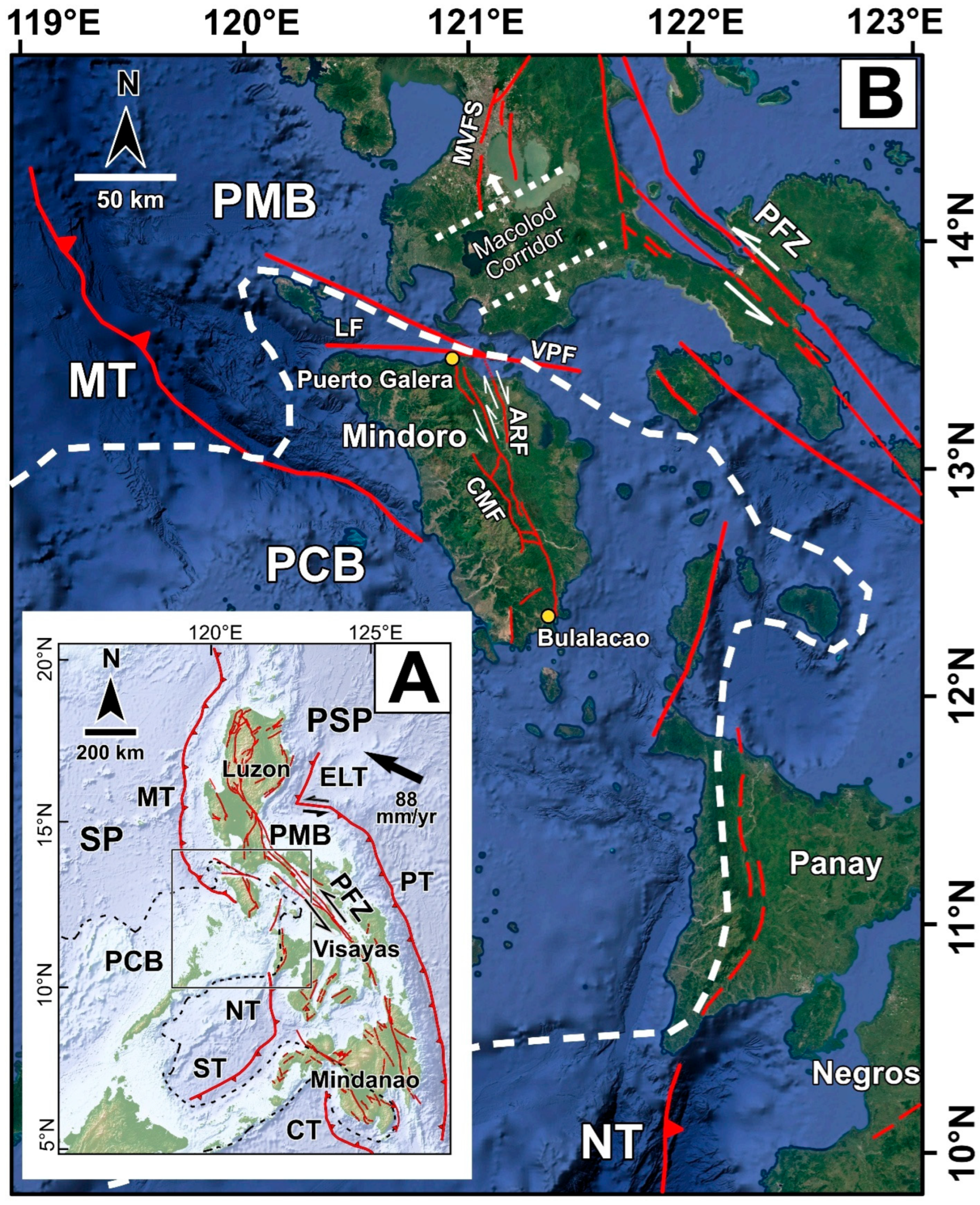
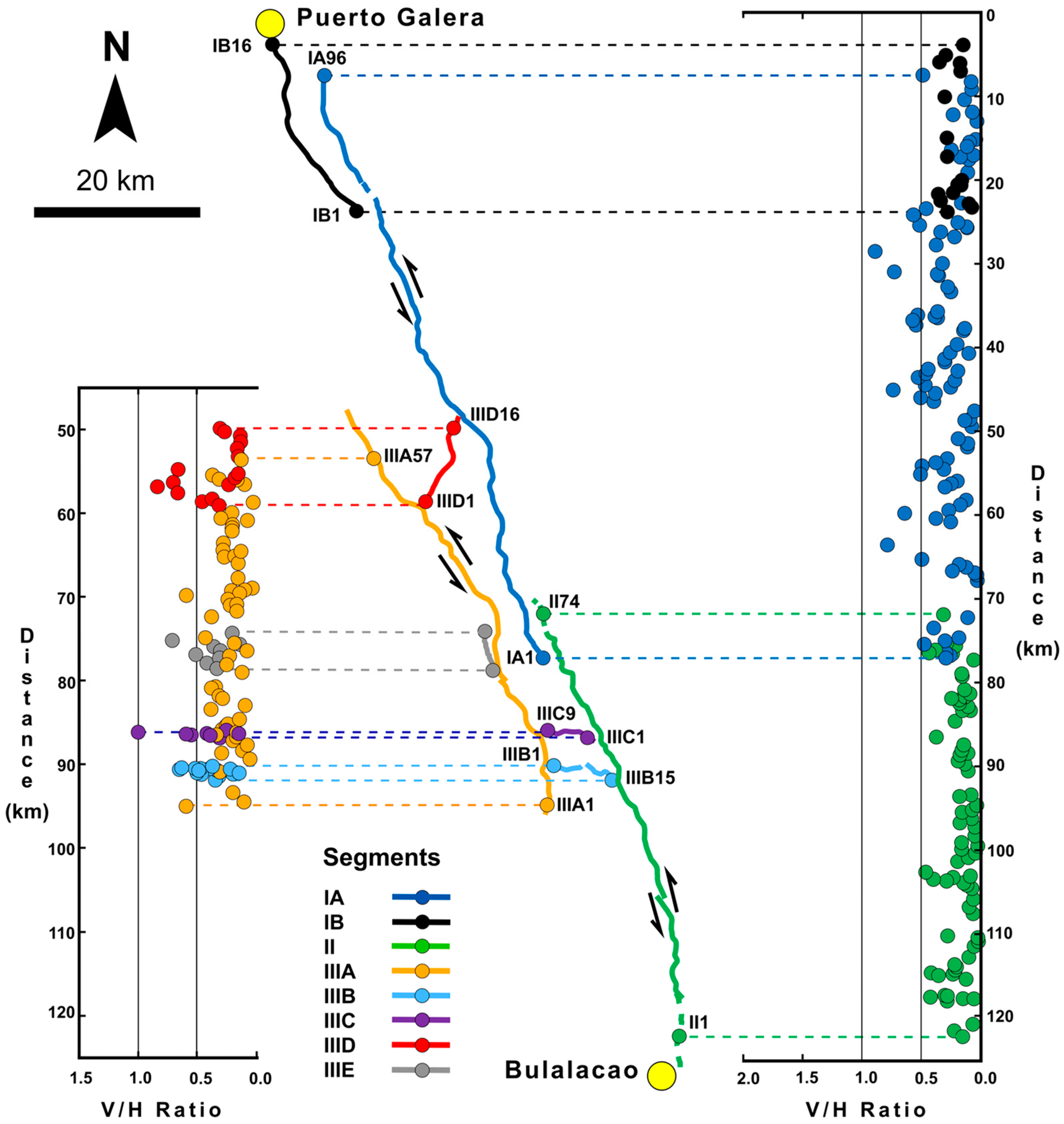
2. Background
2.1. Tectonic Setting
2.2. Geomorphology
2.3. Geology
2.4. Climatic Setting
3. Materials and Methods
3.1. Hypsometric Attributes
3.2. Basin Elongation Ratio (Re)
3.3. Volume to Area Ratio (RVA)
3.4. Valley Floor Width to Valley Height Ratio (Vf)
3.5. Normalized Channel Steepness Indices (ksn)
4. Results
5. Discussion
6. Conclusions
- (1)
- There are two possible spatial distributions of uplift rates that are applicable since at least the Pleistocene, taking into consideration both lithological heterogeneities and climatic gradients:
- at least 20–30 km-long high uplift rates section in the northwestern end of the CMF-bound mountain range (CMF segment I), and
- at most, possibly the entire CMF with moderate to high uplift rates. The inferred spatial trends in uplift rates from this study are consistent with the fault offset plots from earlier detailed mapping of the CMF.
- (2)
- Knowledge of the relatively high uplift areas along the CMF can aid in identifying areas that are more tectonically active, by making assumptions about the CMF’s fault dip and its uniformity (steep fault dip, based on the outcrop pattern of the CMF’s trace), and by limiting one’s search to areas with similar vertical-to-horizontal displacement ratios (V/H) sites along the CMF. Doing so can help narrow down priority sites for more detailed field-based neotectonic and paleoseismic studies from which information for seismic hazard assessments, such as possible earthquake magnitude, return periods, and slip rates, can be derived. Based on fault offset measurements and our knowledge of high uplift areas from this study, future work aimed at estimating the CMF’s seismogenic capability will likely benefit the most from focusing on sites along CMF segments I and III.
Supplementary Materials
Author Contributions
Funding
Data Availability Statement
Acknowledgments
Conflicts of Interest
References
- Rimando, R.; Rimando, J. The Central Mindoro Fault: An Active Sinistral Fault Within the Translational Boundary Between the Palawan Microcontinental Block and the Philippine Mobile Belt. GeoHazards 2025, 6, 6. [Google Scholar] [CrossRef]
- Seno, T.; Stein, S.; Gripp, A.E. A model for the motion of the Philippine Sea plate consistent with NUVEL-1 and geological data. J. Geophys. Res. Solid Earth 1993, 98, 17941–17948. [Google Scholar] [CrossRef]
- Rimando, R.; Rimando, J.; Lim, R. Complex Shear Partitioning involving the 6 February 2012 Mw 6.7 Negros Earthquake Ground Rupture in Central Philippines. Geosciences 2020, 10, 460. [Google Scholar] [CrossRef]
- Philippine Institute of Volcanology and Seismology (PHIVOLCS). The PHIVOLCS Faultfinder. 2025. Available online: http://faultfinder.phivolcs.dost.gov.ph/ (accessed on 2 January 2025).
- Metal Mining Agency of Japan–Japan International Cooperation Agency (MMAJ-JICA). Report on the Geological Survey of Mindoro Island Consolidated Report; MMAJ-JICA: Metro Manila, Philippines, 1984; Volume 57. [Google Scholar]
- Karig, D.E.; Sarewitz, D.R.; Haeck, G.D. Role of strike-slip faulting in the evolution of allochthonous terranes in the Philippines. Geology 1986, 14, 852–855. [Google Scholar] [CrossRef]
- Mines and Geosciences Bureau (MGB). Geology of the Philippines, 2nd ed.; Mines and Geosciences Bureau, Department of Environment and Natural Resources: Quezon City, Philippines, 2010. [Google Scholar]
- Rangin, C.; Stephan, J.F.; Blanchet, R.; Baladad, D.; Bouysee, P.; Chen, M.P.; Chotin, P.; Collot, J.; Daniel, J.; Drouhot, J.M.; et al. Seabeam survey at the southern end of the Manila trench. Transition between subduction and collision processes, offshore Mindoro Island, Philippines. Tectonophysics 1988, 146, 261–278. [Google Scholar] [CrossRef]
- Sarewitz, D.R.; Karig, D.E. Processes of allochthonous terrane evolution, Mindoro Island, Philippines. Tectonics 1986, 5, 525–552. [Google Scholar] [CrossRef]
- Sarmiento, K.J.S.; Aurelio, M.A.; Flores, P.C.M.; Carrillo, A.D.V.; Marfito, B.J.; Abigania, M.I.T.; Daag, A.S.; Siringan, F.P. Seafloor structures and static stress changes associated with two recent earthquakes in offshore southern Batangas, Philippines. Front. Earth Sci. 2022, 9, 801670. [Google Scholar] [CrossRef]
- Wynne, D.B.; McCabe, R.; Mazzullo, J.; Malicse, A. Terrane suturing, Mindoro, Philippines. In Proceedings of the Abstracts and Programs of the Annual Meeting of the Geological Society of America 1985, Orlando, FL, USA, 28–31 October 1985. [Google Scholar]
- Rimando, R.; Rimando, J. Morphotectonic Kinematic Indicators Along the Vigan-Aggao Fault—The Western Deformation Front of the Philippine Fault Zone in Northern Luzon, Philippines. Geosciences 2020, 10, 83. [Google Scholar] [CrossRef]
- Nakata, T.; Tsutsumi, H.; Punongbayan, R.S.; Rimando, R.E.; Daligdig, J.A.; Daag, A.S.; Besana, G.M. Surface Faulting Associated with the Philippine Earthquake of 1990. J. Geogr. (Chigaku Zasshi) 1990, 99, 515–532. [Google Scholar] [CrossRef][Green Version]
- Rimando, R.E.; Knuepfer, P.L.K. Neotectonics of the Marikina Valley fault system (MVFS) and tectonic framework of structures in northern and central Luzon, Philippines. Tectonophysics 2006, 415, 17–38. [Google Scholar] [CrossRef]
- Rimando, R.E.; Kurita, K.; Kinugasa, Y. Spatial and temporal variation of aseismic creep along the dilational jog of the West Valley Fault, Philippines: Hazard implications. Front. Earth Sci. 2022, 10, 935161. [Google Scholar] [CrossRef]
- Rimando, R.E.; Knuepfer, P.L. Tectonic Control of Aseismic Creep and Potential for Induced Seismicity Along the West Valley Fault in Southeastern Metro Manila, Philippines. GeoHazards 2024, 5, 1172–1189. [Google Scholar] [CrossRef]
- Rimando, R.E.; Knuepfer, P.L. Earthquake History and Rupture Extents from Morphology of Fault Scarps Along the Valley Fault System (Philippines). GeoHazards 2025, 6, 23. [Google Scholar] [CrossRef]
- Rimando, R.E.; Punongbayan, R.S.; Geronimo-Catane, S.G.; Mirabueno, H.S.; Rasdas, A.S. Ground rupture of the 15 November 1994 Oriental Mindoro (Philippines) earthquake. In Proceedings of the Abstracts of the XXI General Assembly of IUGG, Boulder, CO, USA, 2–14 July 1995. [Google Scholar]
- Rimando, J.; Aurelio, M.; Dianala, J.D.; Taguibao, K.J.; Agustin, K.M.; Berador, A.E.; Vazquez, A. Coseismic ground rupture of the 15 October 2013 magnitude (Mw) 7.2 Bohol Earthquake, Bohol island, Central Philippines. Tectonics 2019, 38, 2558–2580. [Google Scholar] [CrossRef]
- Llamas, D.C.E.; Marfito, B.J.; Dela Cruz, R.; Aurelio, M.A. Surface rupture and fault characteristics associated with the 2020 magnitude (Mw) 6.6 Masbate earthquake, Masbate Island, Philippines. Tectonics 2024, 43, e2023TC008106. [Google Scholar] [CrossRef]
- Cantillep, A.M.F.; Ramos, N.T.; Rimando, J. Relative Uplift Rates along the Vigan-Aggao Fault in Ilocos Norte, Philippines Evaluated Through Morphometric Analysis. Geomorphica 2024, 1, 28. [Google Scholar] [CrossRef]
- Rimando, J.; Schoenbohm, L.; Costa, C.; Owen, L.; Cesta, J.; Richard, A.; Gardini, C. Late Quaternary Activity of the La Rinconada Fault Zone, San Juan, Argentina. Tectonics 2019, 38, 916–940. [Google Scholar] [CrossRef]
- Rimando, J.; Schoenbohm, L.; Ortiz, G.; Alvarado, P.; Venerdini, A.; Owen, L.; Seagren, E.; Figueiredo, P.; Hammer, S. Late Quaternary Intraplate Deformation Defined by the Las Chacras Fault Zone, West-Central Argentina. Tectonics 2021, 40, e2020TC006509. [Google Scholar] [CrossRef]
- Hollenstein, C.; Müller, M.D.; Geiger, A.; Kahle, H.G. Crustal Motion and Deformation in Greece from a Decade of GPS Measurements, 1993–2003. Tectonophysics 2008, 449, 17–40. [Google Scholar] [CrossRef]
- Lazos, I.; Chatzipetros, A.; Pavlides, S.; Pikridas, C.; Bitharis, S. Tectonic Crustal Deformation of Corinth Gulf, Greece, Based on Primary Geodetic Data. Acta Geodyn. Geomater. 2020, 17, 4. [Google Scholar] [CrossRef]
- Müller, M.D.; Geiger, A.; Kahle, H.G.; Veis, G.; Billiris, H.; Paradissis, D.; Felekis, S. Velocity and Deformation Fields in the North Aegean Domain, Greece, and Implications for Fault Kinematics, Derived from GPS Data 1993–2009. Tectonophysics 2013, 597, 34–49. [Google Scholar] [CrossRef]
- Hamilton, W.B. Tectonics of the Indonesian Region, Professional Paper; US Geological Survey: Washington, DC, USA, 1979; p. 345. [Google Scholar]
- Acharya, H.K.; Aggarwal, Y.P. Seismicity and tectonics of the Philippine Islands. J. Geophys. Res. 1980, 85, 3239–3250. [Google Scholar] [CrossRef]
- Bautista, B.C.; Bautista, M.L.P.; Oike, K.; Wu, F.T.; Punongbayan, R.S. A new insight on the geometry of subducting slabs in northern Luzon, Philippines. Tectonophysics 2001, 339, 279–310. [Google Scholar] [CrossRef]
- Cardwell, R.K.; Isacks, B.L.; Karig, D.E. The spatial distribution of earthquakes, focal mechanism solutions, and subducted lithosphere in the Philippine and northeastern Indonesian Islands. In The Tectonic and Geologic Evolution of Southeast Asian Seas and Islands; Hayes, D.E., Ed.; American Geophysical Union: Washington, DC, USA, 1980; pp. 1–35. [Google Scholar] [CrossRef]
- Hamburger, M.; Cardwell, R.; Isacks, B. Seismotectonics of the Luzon, Philippines, region. In The Tectonic and Geologic Evolution of Southeast Asian Seas and Islands; Hayes, D.E., Ed.; American Geophysical Union: Washington, DC, USA, 1983; pp. 1–35. [Google Scholar] [CrossRef]
- Hayes, D.E.; Lewis, S.D. Structure and tectonics of the Manila Trench System, western Luzon, Philippines. Energy 1985, 10, 263–279. [Google Scholar] [CrossRef]
- Ozawa, A.; Tagami, T.; Listanco, E.L.; Arpa, C.B.; Sudo, M. Initiation and propagation of subduction along the Philippine Trench: Evidence from the temporal and spatial distribution of volcanoes. J. Asian Earth Sci. 2004, 23, 105–111. [Google Scholar] [CrossRef]
- Allen, C.R. Circum-Pacific faulting in the Philippines-Taiwan region. J. Geophys. Res. 1962, 67, 4795–4812. [Google Scholar] [CrossRef]
- Marfito, B.J.; Llamas, D.C.E.; Aurelio, M.A. Geometry and segmentation of the Philippine Fault in Surigao Strait. Front. Earth Sci. 2022, 10, 799803. [Google Scholar] [CrossRef]
- Pinet, N.; Stephan, J.F. The Philippine wrench fault system in the Ilocos Foothills, northwestern Luzon, Philippines. Tectonophysics 1990, 183, 207–224. [Google Scholar] [CrossRef]
- Mitchell, A.H.G.; Hernandez, F.T.; Dela Cruz, A.P. Cenozoic evolution of the Philippine Archipelago. J. Southeast Asian Earth Sci. 1986, 1, 3–22. [Google Scholar] [CrossRef]
- Gervasio, F.C. A study of the tectonics of the Philippine archipelago. Philipp. Geol. 1966, 20, 51–74. [Google Scholar]
- Karig, D.E. Accreted terranes in the northern part of the Philippine archipelago. Tectonics 1983, 2, 211–236. [Google Scholar] [CrossRef]
- Rangin, C.; Stephan, J.F.; Muller, C. Middle Oligocene oceanic crust of South China Sea jammed into Mindoro collision zone (Philippines). Geology 1985, 13, 425–428. [Google Scholar] [CrossRef]
- Marchadier, Y.; Rangin, C. Polyphase tectonics at the southern tip of the Manila trench, Mindoro-Tablas Islands, Philippines. Tectonophysics 1990, 183, 273–287. [Google Scholar] [CrossRef]
- Taylor, B.; Hayes, D.E. The Tectonic Evolution of the South China Basin. In The Tectonic and Geologic Evolution of Southeast Asian Seas and Islands; Hayes, D.E., Ed.; American Geophysical Union: Washington, DC, USA, 1980; pp. 89–104. [Google Scholar] [CrossRef]
- Holloway, N.H. North Palawan block, Philippines—Its relation to Asian mainland and role in evolution of South China Sea. AAPG Bull. 1982, 66, 1355–1383. [Google Scholar] [CrossRef]
- McCabe, R.; Almasco, J.; Diegor, W. Geologic and paleomagnetic evidence for a possible Miocene collision in western Panay, central Philippines. Geology 1982, 10, 325–329. [Google Scholar] [CrossRef]
- Yumul, G.P.; Dimalanta, C.B.; Tamayo, R.A. Indenter-tectonics in the Philippines: Example from the Palawan Microcontinental Block-Philippine Mobile Belt Collision. Resour. Geol. 2005, 55, 189–198. [Google Scholar] [CrossRef]
- Bookhagen, B.; Strecker, M.R. Spatiotemporal trends in erosion rates across a pronounced rainfall gradient: Examples from the southern Central Andes. Earth Planet. Sci. Lett. 2012, 327, 97–110. [Google Scholar] [CrossRef]
- Tucker, G.E. Drainage basin sensitivity to tectonic and climatic forcing: Implications of a stochastic model for the role of entrainment and erosion thresholds. Earth Surf. Process. Landf. 2004, 29, 185–205. [Google Scholar] [CrossRef]
- Molnar, P.; Anderson, R.S.; Kier, G.; Rose, J. Relationships among probability distributions of stream discharges in floods, climate, bed load transport, and river incision. J. Geophys. Res. Earth Surf. 2006, 111, F2. [Google Scholar] [CrossRef]
- Attal, M.; Cowie, P.A.; Whittaker, A.C.; Hobley, D.; Tucker, G.E.; Roberts, G.P. Testing fluvial erosion models using the transient response of bedrock rivers to tectonic forcing in the Apennines, Italy. J. Geophys. Res. Earth Surf. 2011, 116, F2. [Google Scholar] [CrossRef]
- Coronas, J. The Climate and Weather of the Philippines, 1908 to 1918; Bureau of Printing: Manila, Philippines, 1920. [Google Scholar]
- Kintanar, R.L. Climate of the Philippines; Philippine Atmospheric, Geophysical and Astronomical Services Administration (PAGASA): Quezon City, Philippines, 1984. [Google Scholar]
- PAGASA. Climate Data in the Philippines; Philippine Atmospheric, Geophysical and Astronomical Services Administration: Quezon City, Philippines, 2025. Available online: https://www.pagasa.dost.gov.ph/climate/climate-data (accessed on 2 January 2025).
- Ahmad, S.; Alam, A.; Ahmad, B.; Bhat, M.I.; Bhat, M.S. Geomorphic evidence of unrecognized Balapur fault segment in the southwest Kashmir basin of northwest Himalayas. Geomorphology 2015, 250, 159–172. [Google Scholar] [CrossRef]
- Alaei, M.; Dehbozorgi, M.; Ghassemi, M.R.; Nozaem, R. Evaluation of relative tectonic activity of Buin Zahra-Avaj area, northern Iran. Arab. J. Geosci. 2017, 10, 3025. [Google Scholar] [CrossRef]
- Alipoor, R.; Poorkermani, M.; Zare, M.; El Hamdouni, R. Active tectonic assessment around Rudbar Lorestan dam site, High Zagros Belt (SW of Iran). Geomorphology 2011, 128, 1–14. [Google Scholar] [CrossRef]
- Arian, M.; Aram, Z. Relative tectonic activity classification in the Kermanshah area, western Iran. Solid Earth 2014, 5, 1277–1291. [Google Scholar] [CrossRef]
- Azañón, J.M.; Perez-Pena, J.V.; Giaconia, F.; Booth-Rea, G.; Martinez-Martinez, J.M.; Rodríguez-Peces, M.J. Active tectonics in the central and eastern Betic Cordillera through morphotectonic analysis: The case of Sierra Nevada and Sierra Alhamilla. J. Iber. Geol. 2012, 38, 225–238. [Google Scholar] [CrossRef]
- Azor, A.; Keller, E.A.; Yeats, R.S. Geomorphic indicators of active fold growth: South Mountain–Oak Ridge anticline, Ventura basin, southern California. Geol. Soc. Am. Bull. 2002, 114, 745–753. [Google Scholar] [CrossRef]
- Chang, Z.; Sun, W.; Wang, J. Assessment of the relative tectonic activity in the Bailongjiang Basin: Insights from DEM-derived geomorphic indices. Environ. Earth Sci. 2015, 74, 5143–5153. [Google Scholar] [CrossRef]
- Daxberger, H.; Riller, U. Analysis of geomorphic indices in the southern Central Andes (23–28° S): Evidence for pervasive Quaternary to Recent deformation in the Puna Plateau. Geomorphology 2015, 248, 57–76. [Google Scholar] [CrossRef]
- Ehsani, J.; Arian, M. Quantitative analysis of relative tectonic activity in the Jarahi-Hendijan basin area, Zagros, Iran. Geosci. J. 2015, 19, 751–765. [Google Scholar] [CrossRef]
- El Hamdouni, R.; Irigaray, C.; Fernandez, T.; Chacón, J.; Keller, E.A. Assessment of relative active tectonics, southwest border of the Sierra Nevada (southern Spain). Geomorphology 2008, 96, 150–173. [Google Scholar] [CrossRef]
- Gaidzik, K.; Ramírez-Herrera, M.T. Geomorphic indices and relative tectonic uplift in the Guerrero sector of the Mexican forearc. Geosci. Front. 2017, 8, 885–902. [Google Scholar] [CrossRef]
- Gao, M.; Zeilinger, G.; Xu, X.; Wang, Q.; Hao, M. DEM and GIS analysis of geomorphic indices for evaluating recent uplift of the northeastern margin of the Tibetan Plateau, China. Geomorphology 2013, 190, 61–72. [Google Scholar] [CrossRef]
- Giaconia, F.; Booth-Rea, G.; Martínez-Martínez, J.M.; Azañón, J.M.; Pérez-Peña, J.V.; Pérez-Romero, J.; Villegas, I. Geomorphic evidence of active tectonics in the Sierra Alhamilla (eastern Betics, SE Spain). Geomorphology 2012, 145, 90–106. [Google Scholar] [CrossRef]
- Gürbüz, A.; Gürer, Ö.F. Tectonic geomorphology of the North Anatolian fault zone in the lake Sapanca Basin (eastern Marmara Region, Turkey). Geosci. J. 2008, 12, 215–225. [Google Scholar] [CrossRef]
- Gusti, U.; Peace, A.; Rimando, J. Tectonic geomorphology of the Ottawa-Bonnechere Graben, Eastern Canada: Implications for regional uplift and intraplate seismicity. Can. J. Earth Sci. 2023, 60, 635–652. [Google Scholar] [CrossRef]
- Krystopowicz, N.; Schoenbohm, L.M.; Rimando, J.; Brocard, G.; Rojay, B. Tectonic geomorphology and Plio-Quaternary structural evolution of the Tuzgölü fault zone: Implications for deformation in the interior of the Central Anatolian Plateau. Geosphere 2020, 16, 1107–1124. [Google Scholar] [CrossRef]
- Özkaymak, Ç. Tectonic analysis of the Honaz Fault (western Anatolia) using geomorphic indices and the regional implications. Geodin. Acta 2015, 27, 110–129. [Google Scholar] [CrossRef]
- Özkaymak, Ç.; Sözbilir, H. Tectonic geomorphology of the Spildağı high ranges, western Anatolia. Geomorphology 2012, 173, 128–140. [Google Scholar] [CrossRef]
- Özsayın, E. Relative tectonic activity assessment of the Çameli Basin, Western Anatolia, using geomorphic indices. Geodin. Acta 2016, 28, 241–253. [Google Scholar] [CrossRef]
- Pedrera, A.; Pérez-Peña, J.V.; Galindo-Zaldívar, J.; Azañón, J.M.; Azor, A. Testing the sensitivity of geomorphic indices in areas of low-rate active folding (eastern Betic Cordillera, Spain). Geomorphology 2009, 105, 218–231. [Google Scholar] [CrossRef]
- Pérez-Peña, J.V.; Azor, A.; Azañón, J.M.; Keller, E.A. Active tectonics in the Sierra Nevada (Betic Cordillera, SE Spain): Insights from geomorphic indexes and drainage pattern analysis. Geomorphology 2010, 119, 74–87. [Google Scholar] [CrossRef]
- Peters, G.; van Balen, R.T. Tectonic geomorphology of the northern Upper Rhine graben, Germany. Glob. Planet. Change 2007, 58, 310–334. [Google Scholar] [CrossRef]
- Rimando, J.M.; Schoenbohm, L.M. Regional relative tectonic activity of structures in the Pampean flat slab segment of Argentina from 30 to 32° S. Geomorphology 2020, 350, 106908. [Google Scholar] [CrossRef]
- Rockwell, T.K.; Keller, E.A.; Johnson, D.L. Tectonic geomorphology of alluvial fans and mountain fronts near Ventura, California. In Tectonic Geomorphology; Morisawa, M., Ed.; Proceedings of the 15th Annual Geomorphology Symposium; Allen and Unwin Publishers: Boston, MA, USA, 1985; pp. 183–207. [Google Scholar]
- Selim, H.H.; Tüysüz, O.; Karakaş, A.; Taş, K.Ö. Morphotectonic evidence from the southern branch of the North Anatolian Fault (NAF) and basins of the south Marmara sub-region, NW Turkey. Quat. Int. 2013, 292, 176–192. [Google Scholar] [CrossRef]
- Silva, P.G.; Goy, J.L.; Zazo, C.; Bardají, T. Fault-generated mountain fronts in southeast Spain: Geomorphologic assessment of tectonic and seismic activity. Geomorphology 2003, 50, 203–225. [Google Scholar] [CrossRef]
- Viveen, W.; Van Balen, R.T.; Schoorl, J.M.; Veldkamp, A.; Temme, A.J.A.M.; Vidal-Romani, J.R. Assessment of recent tectonic activity on the NW Iberian Atlantic Margin by means of geomorphic indices and field studies of the Lower Miño River terraces. Tectonophysics 2012, 544, 13–30. [Google Scholar] [CrossRef]
- Watkinson, I.M.; Hall, R. Fault systems of the eastern Indonesian triple junction: Evaluation of Quaternary activity and implications for seismic hazards. Geol. Soc. Lond. Spec. Publ. 2017, 441, 71–120. [Google Scholar] [CrossRef]
- Wells, S.G.; Bullard, T.F.; Menges, C.M.; Drake, P.G.; Karas, P.A.; Kelson, K.I.; Ritter, J.B.; Wesling, J.R. Regional variations in tectonic geomorphology along a segmented convergent plate boundary, Pacific coast of Costa Rica. Geomorphology 1988, 1, 239–265. [Google Scholar] [CrossRef]
- Yıldırım, C. Relative tectonic activity assessment of the Tuz Gölü fault zone; Central Anatolia, Turkey. Tectonophysics 2014, 630, 183–192. [Google Scholar] [CrossRef]
- Bull, W.B. Tectonic Geomorphology of Mountains: A New Approach to Paleo-Seismology; John Wiley & Sons: Hoboken, NJ, USA, 2008. [Google Scholar] [CrossRef]
- Bull, W.B.; McFadden, L.D. Tectonic geomorphology North and South of the Garlock Fault, California. In Geomorphology in Arid Regions: A Proceedings Volume of the 8th Annual Geomorphology Symposium; Doehring, D.O., Ed.; State University of New York: Binghamton, NY, USA, 1977; pp. 115–138. [Google Scholar] [CrossRef]
- Merritts, D.; Vincent, K.R. Geomorphic response of coastal streams to low, intermediate, and high rates of uplift, Medocino triple junction region, northern California. Geol. Soc. Am. Bull. 1989, 101, 1373–1388. [Google Scholar] [CrossRef]
- Rimando, J. Distribution and Rates of Quaternary Deformation within the Pampean Flat Slab Segment of the Central Andes of Argentina from 30–32° S. Doctoral Dissertation, University of Toronto, Toronto, ON, Canada, 2020. [Google Scholar]
- Strahler, A.N. Hypsometric (area-altitude) analysis of erosional topography. Geol. Soc. Am. Bull. 1952, 63, 1117–1142. [Google Scholar] [CrossRef]
- Carson, M.A.; Kirkby, M.J. Hillslope Form and Process; Cambridge University Press: London, UK, 1972. [Google Scholar]
- Chorley, R.J.; Kennedy, B.A. Physical Geography: A Systems Approach; Prentice-Hall International Inc.: London, UK, 1971. [Google Scholar]
- Chen, Y.C.; Sung, Q.; Cheng, K.Y. Along-strike variations of morphotectonic features in the Western Foothills of Taiwan: Tectonic implications based on stream-gradient and hypsometric analysis. Geomorphology 2003, 56, 109–137. [Google Scholar] [CrossRef]
- Lifton, N.A.; Chase, C.G. Tectonic, climatic and lithologic influences on landscape fractal dimension and hypsometry: Implications for landscape evolution in the San Gabriel Mountains, California. Geomorphology 1992, 5, 77–114. [Google Scholar] [CrossRef]
- Harlin, J.M. Statistical moments of the hypsometric curve and its density function. J. Int. Assoc. Math. Geol. 1978, 10, 59–72. [Google Scholar] [CrossRef]
- Pérez-Peña, J.V.; Azañón, J.M.; Azor, A. CalHypso: An ArcGIS extension to calculate hypsometric curves and their statistical moments. Applications to drainage basin analysis in SE Spain. Comput. Geosci. 2009, 35, 1214–1223. [Google Scholar] [CrossRef]
- Schumm, S.A. Evolution of drainage systems and slopes in badlands at Perth Amboy, New Jersey. Geol. Soc. Am. Bull. 1956, 67, 597–646. [Google Scholar] [CrossRef]
- Cannon, P.J. Generation of explicit parameters for a quantitative geomorphic study of Mill Creek drainage basin. Okla. Geol. Notes 1976, 36, 3–16. [Google Scholar]
- Ramírez-Herrera, M.T. Geomorphic assessment of active tectonics in the Acambay Graben, Mexican volcanic belt. Earth Surf. Process. Landf. 1998, 23, 317–332. [Google Scholar] [CrossRef]
- Schumm, S.A.; Parker, R.S. Implications of complex response of drainage systems for Quaternary alluvial stratigraphy. Nat. Phys. Sci. 1973, 243, 99–100. [Google Scholar] [CrossRef]
- Jorgensen Harbor, D. Landscape evolution at the margin of the Basin and Range. Geology 1997, 25, 1111–1114. [Google Scholar] [CrossRef]
- Ouchi, S. Effects of uplift on the development of experimental erosion landform. In Geological Society of America Abstracts with Programs; Geological Society of America: Boulder, CO, USA, 2002; Volume 34, p. 129. [Google Scholar]
- Bonnet, S.; Crave, A. Landscape response to climate change: Insights from experimental modeling and implications for tectonic versus climatic uplift of topography. Geology 2003, 31, 123–126. [Google Scholar] [CrossRef]
- Lague, D.; Crave, A.; Davy, P. Laboratory experiments simulating the geomorphic response to tectonic uplift. J. Geophys. Res. Solid Earth 2003, 108, ETG-3. [Google Scholar] [CrossRef]
- Frankel, K.L.; Pazzaglia, F.J. Tectonic geomorphology, drainage basin metrics, and active mountain fronts. Geogr. Fis. Dinam. Quat. 2005, 28, 7–21. [Google Scholar]
- Frankel, K.L.; Pazzaglia, F.J. Mountain fronts, base-level fall, and landscape evolution: Insights from the southern Rocky Mountains. In Tectonics, Climate, and Landscape Evolution; Willett, S.D., Hovius, N., Brandon, M.T., Fisher, D.M., Eds.; Geological Society of America Special Paper 398; Geological Society of America: Boulder, CO, USA, 2006; pp. 419–434. [Google Scholar] [CrossRef]
- Whipple, K.X.; Tucker, G.E. Implications of sediment-flux-dependent river incision models for landscape evolution. J. Geophys. Res. Solid Earth 2002, 107, ETG-3. [Google Scholar] [CrossRef]
- Snyder, N.P.; Whipple, K.X.; Tucker, G.E.; Merritts, D.J. Landscape response to tectonic forcing: Digital elevation model analysis of stream profiles in the Mendocino triple junction region, northern California. Geol. Soc. Am. Bull. 2000, 112, 1250–1263. [Google Scholar] [CrossRef]
- Kirby, E.; Whipple, K.X.; Tang, W.; Chen, Z. Distribution of active rock uplift along the eastern margin of the Tibetan Plateau: Inferences from bedrock channel longitudinal profiles. J. Geophys. Res. Solid Earth 2003, 108, B4. [Google Scholar] [CrossRef]
- Wobus, C.; Whipple, K.X.; Kirby, E.; Snyder, N.; Johnson, J.; Spyropolou, K.; Crosby, B.; Sheehan, D. Tectonics from topography: Procedures, promise, and pitfalls. In Tectonics, Climate, and Landscape Evolution; Willett, S.D., Hovius, N., Brandon, M.T., Fisher, D.M., Eds.; Geological Society of America Special Paper 398; Geological Society of America: Boulder, CO, USA, 2006; pp. 55–96. [Google Scholar] [CrossRef]
- Cyr, A.J.; Granger, D.E.; Olivetti, V.; Molin, P. Quantifying rock uplift rates using channel steepness and cosmogenic nuclide–determined erosion rates: Examples from northern and southern Italy. Lithosphere 2010, 2, 188–198. [Google Scholar] [CrossRef]
- Kirby, E.; Whipple, K.X. Expression of active tectonics in erosional landscapes. J. Struct. Geol. 2012, 44, 54–75. [Google Scholar] [CrossRef]
- Cyr, A.J.; Granger, D.E.; Olivetti, V.; Molin, P. Distinguishing between tectonic and lithologic controls on bedrock channel longitudinal profiles using cosmogenic 10Be erosion rates and channel steepness index. Geomorphology 2014, 209, 27–38. [Google Scholar] [CrossRef]
- Duvall, A.; Kirby, E.; Burbank, D. Tectonic and lithologic controls on bedrock channel profiles and processes in coastal California. J. Geophys. Res. Earth Surf. 2004, 109, F3. [Google Scholar] [CrossRef]
- Hack, J.T. Studies of longitudinal stream profiles in Virginia and Maryland. U.S. Geol. Surv. Prof. Pap. 1957, 294-B, 45–97. [Google Scholar] [CrossRef]
- Robl, J.; Heberer, B.; Prasicek, G.; Neubauer, F.; Hergarten, S. The topography of a continental indenter: The interplay between crustal deformation, erosion, and base level changes in the eastern Southern Alps. J. Geophys. Res. Earth Surf. 2017, 122, 310–334. [Google Scholar] [CrossRef] [PubMed]
- Blum, M.D.; Törnqvist, T.E. Fluvial responses to climate and sea-level change: A review and look forward. Sedimentology 2000, 47, 2–48. [Google Scholar] [CrossRef]
- Schoenbohm, L.M.; Whipple, K.X.; Burchfiel, B.C.; Chen, L. Geomorphic constraints on surface uplift, exhumation, and plateau growth in the Red River region, Yunnan Province, China. Geol. Soc. Am. Bull. 2004, 116, 895–909. [Google Scholar] [CrossRef]
- Whittaker, A.C.; Attal, M.; Cowie, P.A.; Tucker, G.E.; Roberts, G. Decoding temporal and spatial patterns of fault uplift using transient river long profiles. Geomorphology 2008, 100, 506–526. [Google Scholar] [CrossRef]
- Walsh, L.S.; Martin, A.J.; Ojha, T.P.; Fedenczuk, T. Correlations of fluvial knickzones with landslide dams, lithologic contacts, and faults in the southwestern Annapurna Range, central Nepalese Himalaya. J. Geophys. Res. Earth Surf. 2012, 117, F1. [Google Scholar] [CrossRef]
- Kent, E.; Boulton, S.J.; Whittaker, A.C.; Stewart, I.S.; Cihat Alçiçek, M. Normal fault growth and linkage in the Gediz (Alaşehir) Graben, Western Turkey, revealed by transient river long-profiles and slope-break knickpoints. Earth Surf. Process. Landf. 2017, 42, 836–852. [Google Scholar] [CrossRef]
- Rosenbloom, N.A.; Anderson, R.S. Hillslope and channel evolution in a marine terraced landscape, Santa Cruz, California. J. Geophys. Res. Solid Earth 1994, 99, 14013–14029. [Google Scholar] [CrossRef]
- Weissel, J.K.; Seidl, M.A. Inland propagation of erosional escarpments and river profile evolution across the southeast Australian passive continental margin. Geophys. Monogr. Ser. 1998, 107, 189–206. [Google Scholar] [CrossRef]
- Whipple, K.X.; Tucker, G.E. Dynamics of the stream-power river incision model: Implications for height limits of mountain ranges, landscape response timescales, and research needs. J. Geophys. Res. Solid Earth 1999, 104, 17661–17674. [Google Scholar] [CrossRef]
- Niemann, J.D.; Gasparini, N.M.; Tucker, G.E.; Bras, R.L. A quantitative evaluation of Playfair’s law and its use in testing long-term stream erosion models. Earth Surf. Process. Landf. 2001, 26, 1317–1332. [Google Scholar] [CrossRef]
- Whittaker, A.C.; Boulton, S.J. Tectonic and climatic controls on knickpoint retreat rates and landscape response times. J. Geophys. Res. Earth Surf. 2012, 117, F2. [Google Scholar] [CrossRef]
- Castillo, M.; Muñoz-Salinas, E.; Ferrari, L. Response of a landscape to tectonics using channel steepness indices (ksn) and OSL: A case of study from the Jalisco Block, Western Mexico. Geomorphology 2014, 221, 204–214. [Google Scholar] [CrossRef]
- Cannon, J.M.; Murphy, M.A.; Taylor, M. Segmented strain accumulation in the High Himalaya expressed in river channel steepness. Geosphere 2018, 14, 1131–1149. [Google Scholar] [CrossRef]
- García-Delgado, H.; Velandia, F. Tectonic geomorphology of the Serranía de San Lucas (Central Cordillera): Regional implications for active tectonics and drainage rearrangement in the Northern Andes. Geomorphology 2020, 349, 106914. [Google Scholar] [CrossRef]
- Whipple, K.X. Fluvial landscape response time: How plausible is steady-state denudation? Am. J. Sci. 2001, 301, 313–325. [Google Scholar] [CrossRef]
- Wegmann, K.W.; Zurek, B.D.; Regalla, C.A.; Bilardello, D.; Wollenberg, J.L.; Kopczynski, S.E.; Ziemann, J.M.; Haight, S.L.; Apgar, J.D.; Zhao, C.; et al. Position of the Snake River watershed divide as an indicator of geodynamic processes in the greater Yellowstone region, western North America. Geosphere 2007, 3, 272–281. [Google Scholar] [CrossRef]
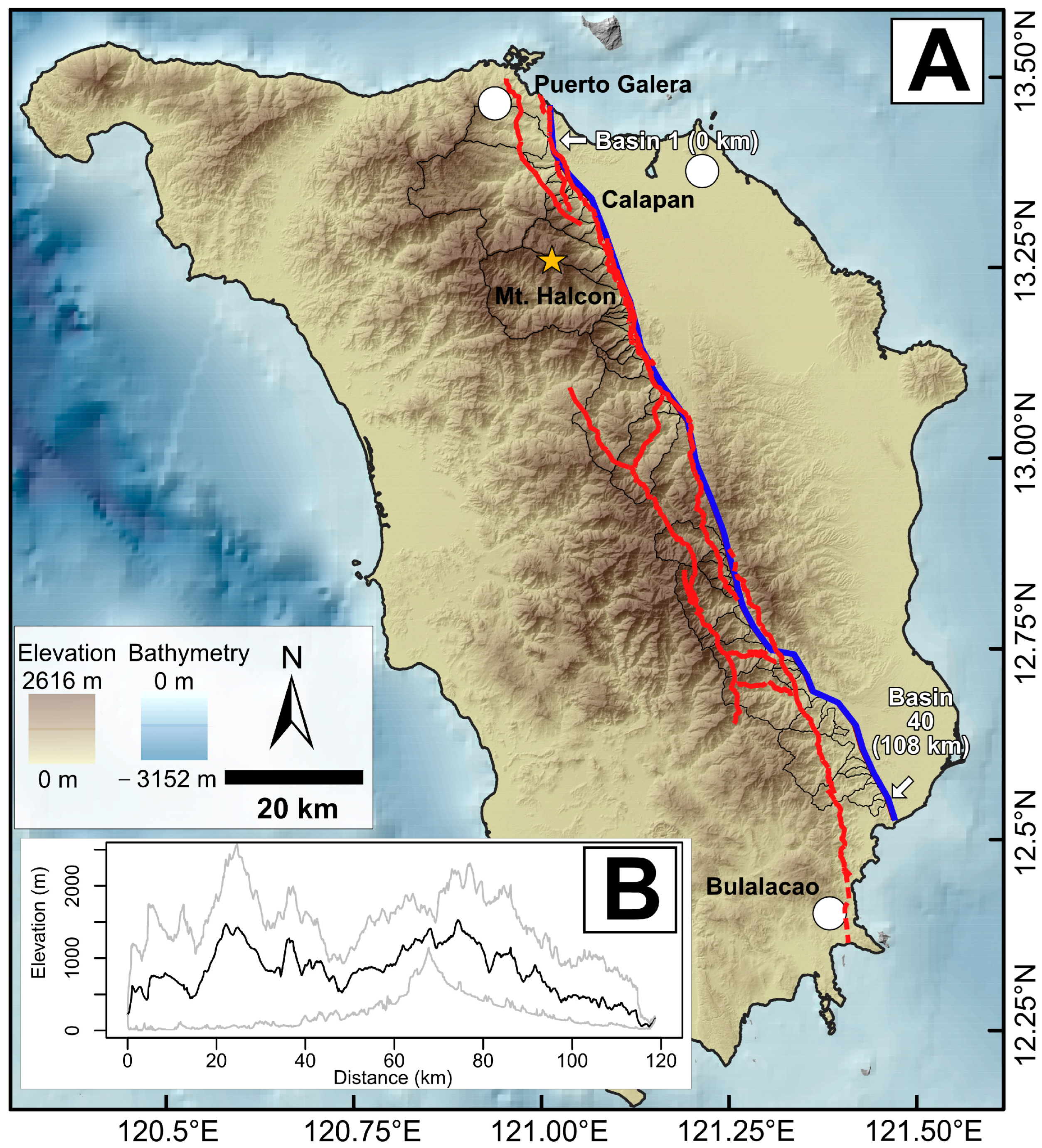

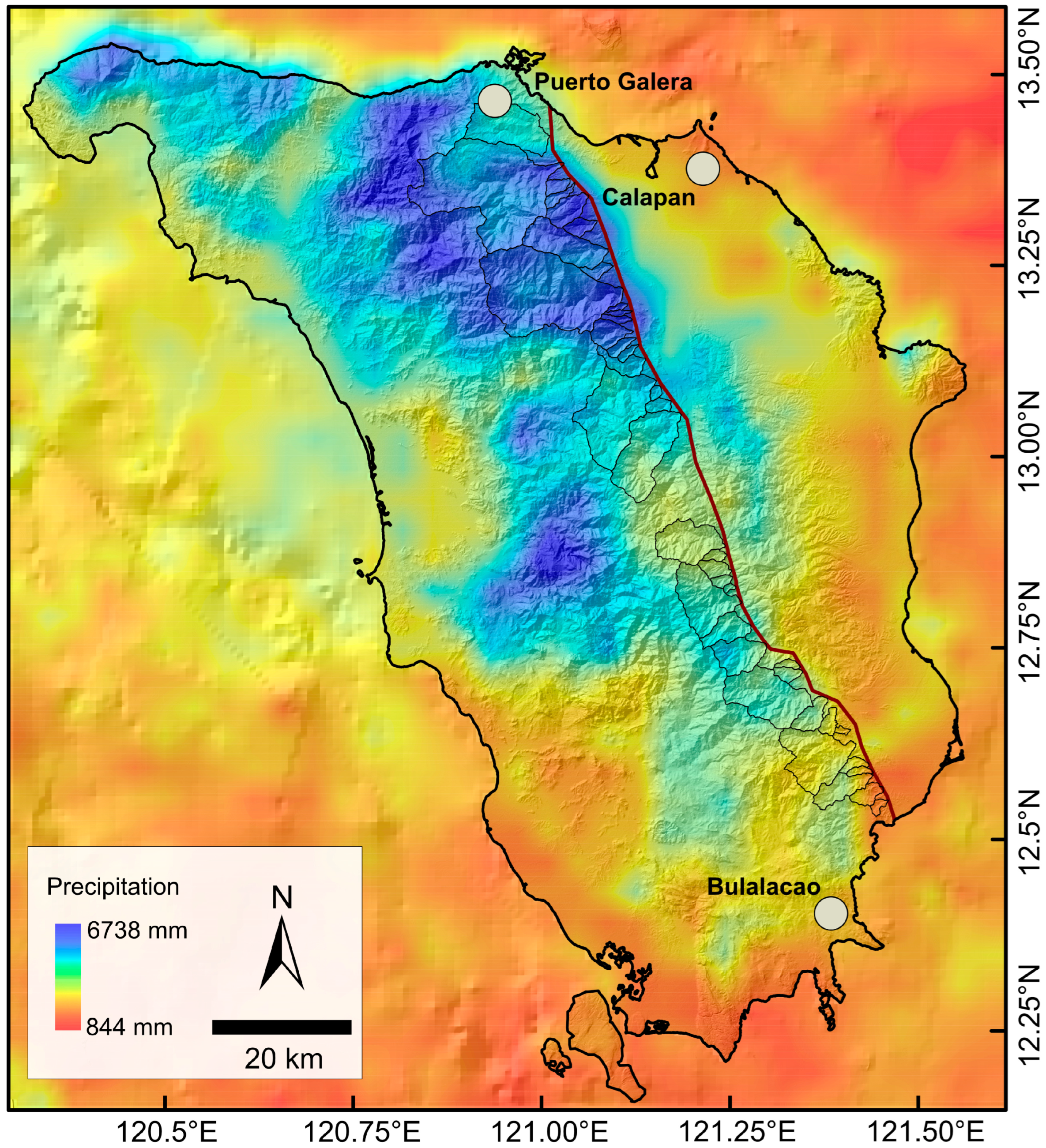
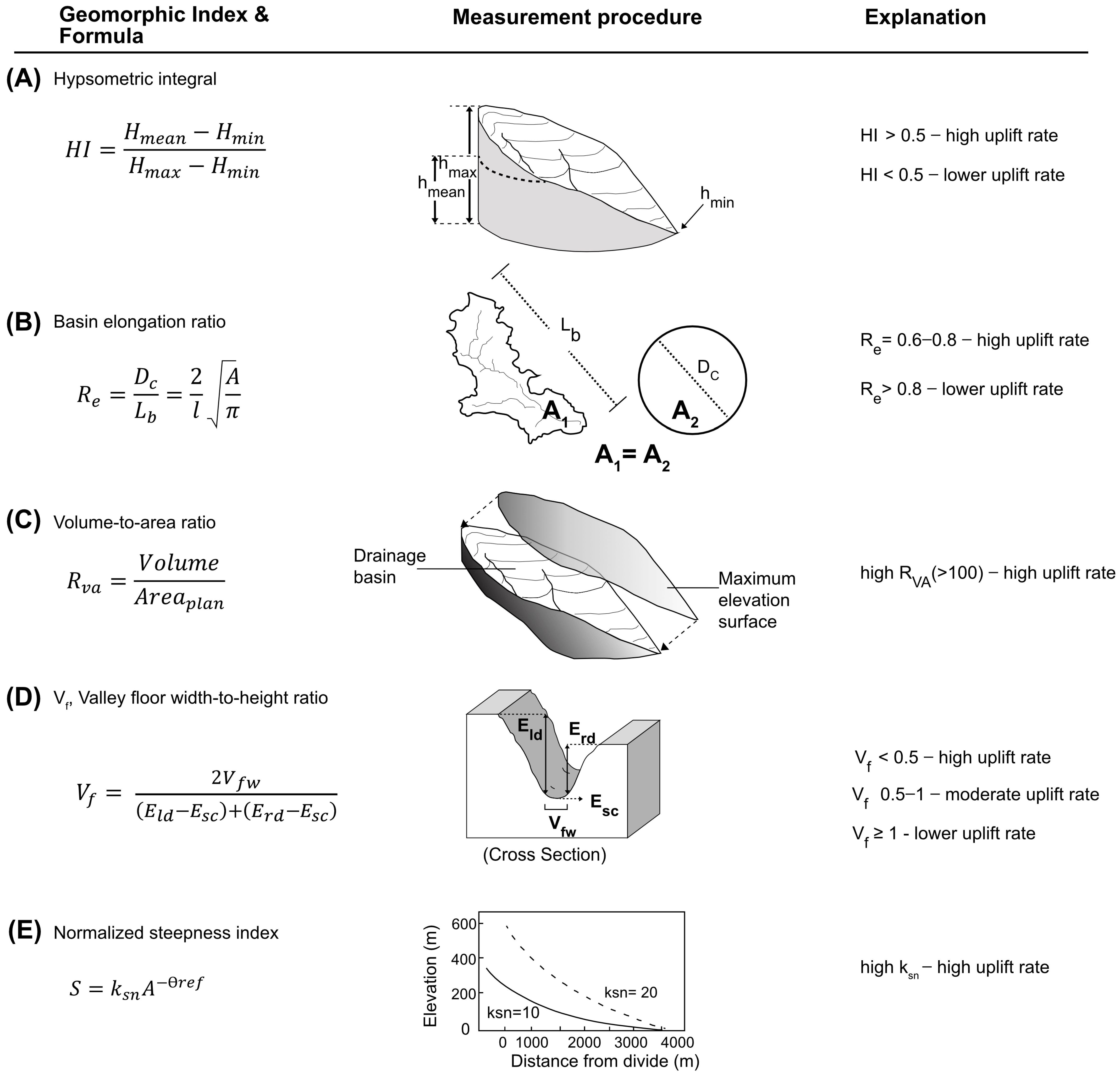


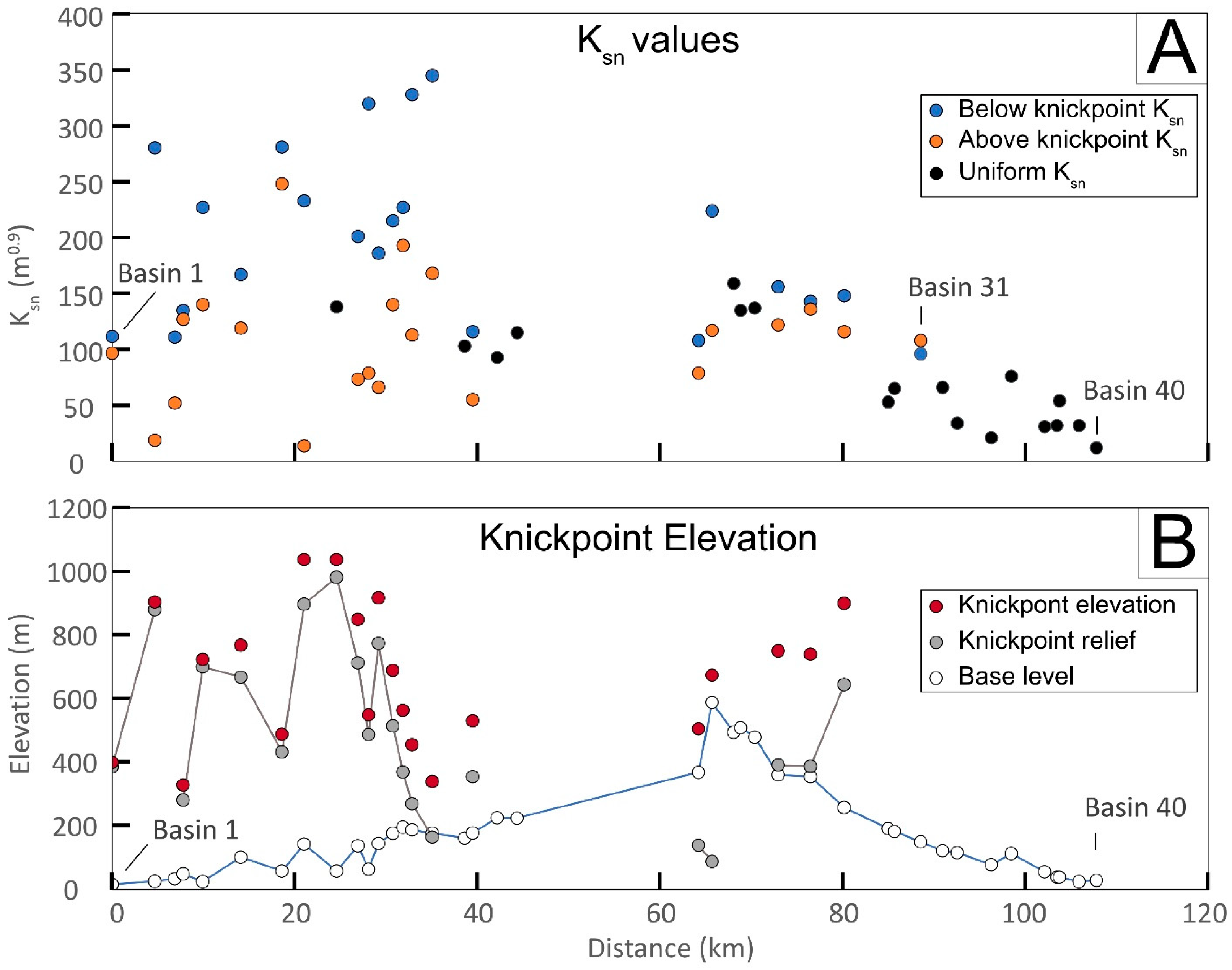
Disclaimer/Publisher’s Note: The statements, opinions and data contained in all publications are solely those of the individual author(s) and contributor(s) and not of MDPI and/or the editor(s). MDPI and/or the editor(s) disclaim responsibility for any injury to people or property resulting from any ideas, methods, instructions or products referred to in the content. |
© 2025 by the authors. Licensee MDPI, Basel, Switzerland. This article is an open access article distributed under the terms and conditions of the Creative Commons Attribution (CC BY) license (https://creativecommons.org/licenses/by/4.0/).
Share and Cite
Rimando, J.; Rimando, R. Relative Uplift Rates Along the Central Mindoro Fault, Philippines. GeoHazards 2025, 6, 57. https://doi.org/10.3390/geohazards6030057
Rimando J, Rimando R. Relative Uplift Rates Along the Central Mindoro Fault, Philippines. GeoHazards. 2025; 6(3):57. https://doi.org/10.3390/geohazards6030057
Chicago/Turabian StyleRimando, Jeremy, and Rolly Rimando. 2025. "Relative Uplift Rates Along the Central Mindoro Fault, Philippines" GeoHazards 6, no. 3: 57. https://doi.org/10.3390/geohazards6030057
APA StyleRimando, J., & Rimando, R. (2025). Relative Uplift Rates Along the Central Mindoro Fault, Philippines. GeoHazards, 6(3), 57. https://doi.org/10.3390/geohazards6030057






